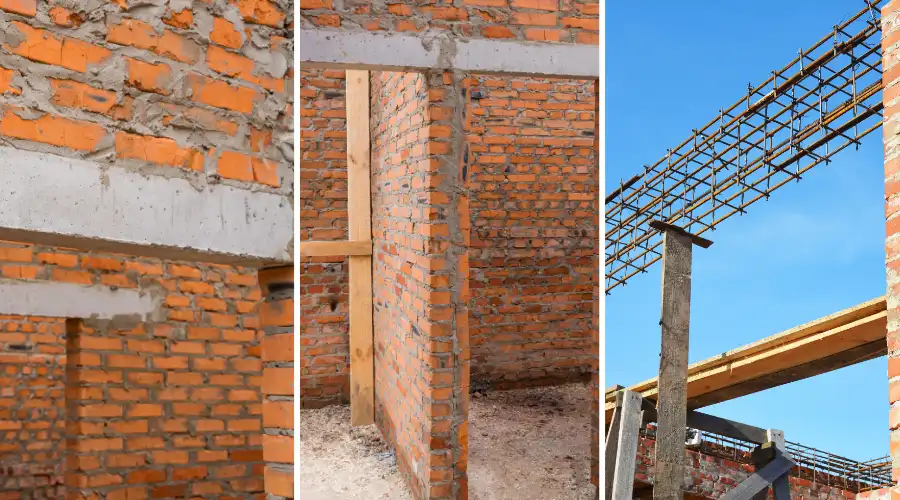Are you thinking about brick lintels for your project? They are strong and have a classic charm that new materials lack. These key masonry elements support doors and windows. They maintain stability and resist lateral forces, enhancing both strength and style. Even with many modern options, brick lintels have always been a preferred choice due to the balanced advantages of performance and tradition that they offer. Whether your project leans towards classic or modern styles, brick lintels will can in any situation.
Let’s review how installing brick lintels enhance strength and style in your project. Keep reading!
What is a Brick Lintel?
A brick lintel is a horizontal structural member constructed of bricks, typically placed above doors, windows and other openings in masonry walls. It supports the load from the wall above while redirecting this load to the sides of the opening and preventing a failure or any potential sagging.
Brick lintels work in spans where there are small distances to be covered. Brick lintels may be selected due to the appropriate least amount of width (not double the width), the relatively inexpensive price, compatibility with brick masonry walls, and appearance that matches the brick.
Types of Brick Lintels

- Plain Brick Lintels: These are made from well-burnt, high-quality bricks with mortar. Plain lintels would be suitable for small spans (generally less than 1 meter) and can bear small loads.
- Reinforced Brick Lintels: These include steel bars or rods in the brickwork to improve strength and carry greater loads across longer spans. The reinforcement is usually located within the lower part of the RCC lintel, where tensile stresses are highest.
Pros and Cons of Brick Lintels
| Pros | Cons |
| Low-cost since bricks are cheap and locally and easily available. | Limited load-bearing capacity for large spans. |
| Can aesthetically blend with exposed brick walls and surfaces. | Not suitable for heavy load without reinforcement. |
| Multiple design possibilities for short spans. | Very likely to crack if not constructed properly. |
| Simple to procure bricks and build lintels without the need for excessively skilled labour. | More time-consuming to build. |
| Can be reinforced for strength. | Unless good quality, well-burnt bricks and strong mortar are used, strength can be compromised. |
Brick lintels are ideal for projects where cost, aesthetics, and small spans are driving considerations, but may not be a suitable option for larger openings or heavier loading unless reinforced.
Materials Used in Brick Lintels
- Bricks: To achieve good performance and longevity, the bricks selected must have good properties and be hard, well burnt, and free from defects.
- Mortar: High strength cement mortar is necessary for stability and to be strong enough to resist separation forces on the brick masonry. Generally, cement mortar is used, although lime mortar may be more ideal for sustainable projects.
- Reinforcement: Reinforced lintels usually consist of steel rods or bars which increase tensile strength and load carrying capacity.
Load-Bearing Capacity of Brick Lintels
Some of the factors that determine a brick lintel’s strength and load-bearing capacity are:
- Span of Opening: Generally, a plain brick lintel can span openings of upto 1 meter, beyond which some additional reinforcement will be required.
- Brick Quality: Better bricks and mortar increase load-bearing capacity and strengthen the bond between brick masonry units.
- Reinforcement: Adding reinforcement to brick lintels increases load bearing capacity. This enables the lintels to be used in openings of larger sizes.
- Construction Detailing: It’s crucial to place bricks carefully. This includes how they are arranged, compacted and cured. The placement of reinforcement is also important.
How Are Brick Lintels Constructed?
- Material Selection: Choose high-quality bricks and mortar. For reinforced lintels, select steel that meets the correct grade.
- Preparation: Mark the location and dimensions of the lintel above the opening.
- Laying Bricks: Lay bricks in lifts. Each lift should be 10 cm to 20 cm deep, depending on the span.
- Reinforcement: If needed, place steel rods in the mortar joints at the bottom of the lintel.
- Curing: Let the lintel complete its curing until it gains sufficient strength. Only then, remove any temporary supports.
When to Use Brick Lintels in Construction
- Small Openings: As structural support for windows and doors with spans of less than 1 meter.
- Aesthetically: If you want the visual continuity of your building to be brick masonry.
- Cost Matters: Projects where cost-effectiveness is paramount and where bricks are readily available.
- Low Loads: Where the imposed loads on the brick or reinforced brick lintels are known to be well within safe limits.
Beyond this, for bigger spans or larger loads, concrete or steel lintels are usually suggested because of their higher strength and stability.
Conclusion
Brick lintels continue to be a common choice due to their visually pleasing nature in masonry buildings, especially for short spans and traditional forms of architecture. Brick lintels can be used if you are careful about the load and span considerations, as well as restraints and interactions with adjacent or surrounding structures. Reinforced brick lintel has a good potential for use in contemporary buildings, but very high load-bearing applications should absolutely be avoided. For such applications, a modern, heavier-duty material, such as raw steel or precast or in-situ concrete, would be the better choice.
Frequently Asked Questions (FAQ)
Plain brick lintels are typically suitable for spans up to 1 meter. For longer spans, reinforcement is necessary.
No, plain brick lintels are not recommended for heavy loads. Reinforced brick lintels can support higher loads, but for very large spans or significant loads, concrete or steel lintels are advisable.
Regular inspections to check for cracks, sagging, or displacement is essential. Mortar joints should be checked and repointed if necessary to maintain structural integrity.
Yes, especially in projects emphasizing traditional aesthetics or where exposed brick masonry is predominant. However, for larger spans or higher structural demands, alternative lintel materials are more preferable.

